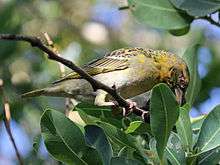Speke's weaver
| Speke's weaver | |
|---|---|
.jpg) | |
| Adult male Soysambu Conservancy, Kenya | |
| Scientific classification | |
| Kingdom: | Animalia |
| Phylum: | Chordata |
| Class: | Aves |
| Order: | Passeriformes |
| Family: | Ploceidae |
| Genus: | Ploceus Cuvier, 1816 |
| Species: | P. spekei |
| Binomial name | |
| Ploceus spekei (Heuglin, 1861) | |

Speke's weaver (Ploceus spekei) is a familiar East African songbird.
The eyes are pale and the bill is on the large side for a weaver. Unlike many weavers, it has the same plumage all year. The adult male is yellow with black throat (edged rusty), face, and bill, and variable black mottling on the back. The adult female's upperparts are dull olive-gray with dusky brown streaks; the underparts are pale yellow, whiter on the belly and grayer on the flanks. The juvenile is similar but duller.[2]
The song is variable; one version is transcribed as "pew…pew…tew, chinkichi-chewchew-skerinkitsitew. Calls include harsh chatter at the nest and "a sharp tseep!" [2]
This species nests in colonies or occasionally singly. The nest, often woven in an acacia, is spherical with a short entrance tube opening sideways or downward. Many grass stems project sloppily, sometimes obscuring the shape.[2] It nests in both the short rainy season and the middle of the long rainy season. Typical clutches comprise four eggs, which are unmarked deep blue, somewhat pointed at both ends, 24 to 26 mm long and 15 to 17 mm wide.[3]
Speke's weaver is found in northern and eastern Somalia, Ethiopia, Kenya (mostly the central highlands), and northeastern Tanzania.[4] It inhabits savanna, bush, agricultural land, and towns.[2] In parts of its range it is common,[2] notably the densely populated area of Nairobi and environs, where it visits bird feeders.[4]
This bird was named in honor of John Speke.[5]
References
| Wikimedia Commons has media related to Ploceus spekei. |
- ↑ BirdLife International (2012). "Ploceus spekei". IUCN Red List of Threatened Species. Version 2013.2. International Union for Conservation of Nature. Retrieved 26 November 2013.
- 1 2 3 4 5 Zimmerman, Dale A.; Turner, Donald A.; Pearson, David J. (1999). Birds of Kenya and Northern Tanzania. Princeton University Press. pp. 248, 536, 541. ISBN 0-691-01022-6.
- ↑ Fuggles-Couchman, NR (1946). "Further Notes on Nesting Habits and the Breeding Seasons of Some Tanganyika Birds". Tanganyika Notes and Records. 4 (21): 9–18. doi:10.1177/002198946900400106. Retrieved 2007-04-08.
- 1 2 "Speke's Weaver". Kenya Birds. Retrieved 2007-04-08.
- ↑ Beolen, Bo; Watkins, Michael (2004). Whose Bird? Common Bird Names and the People They Commemorate. Yale University Press. p. 308. ISBN 0-300-10359-X.
External links
- Speke's weaver - Species text in Weaver Watch.
